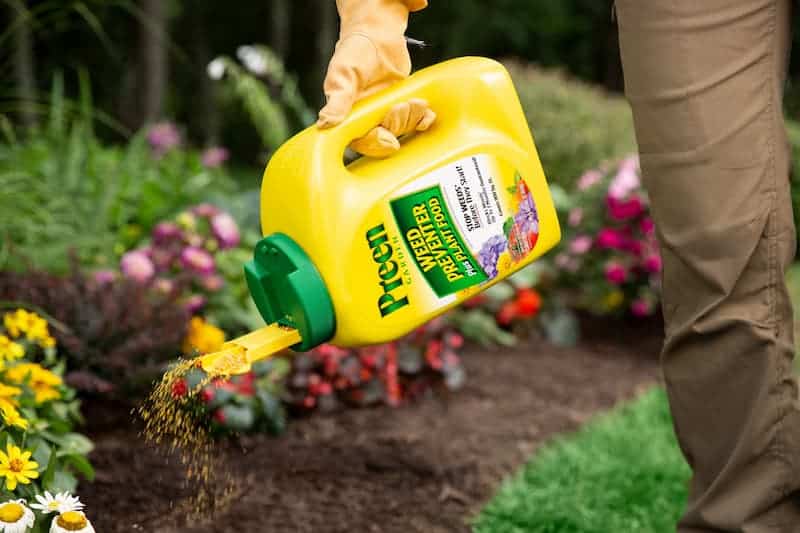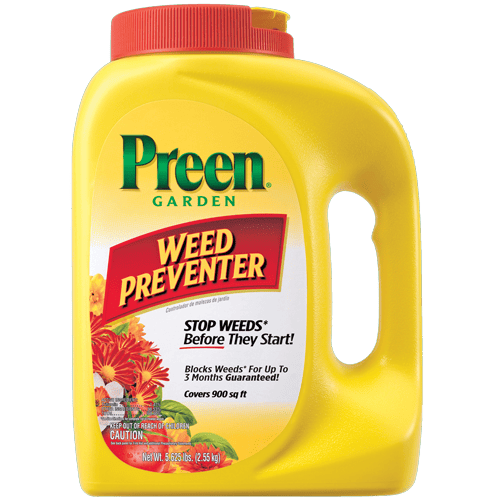Around the world, fertilizers and weed-preventive herbicides are frequently employed in farming, gardening, and other agricultural endeavors. Preen is the best product if you are searching for a simple solution to maintain a productive vegetable garden.
However, are these weedkiller solutions suitable for the environment? What effects does Preen have on the environment and in our gardens? Let us dive in to find out!
What is Preen?
Preen is a type of weed control product that is frequently used in gardens and other outdoor areas. Trifluralin, a pesticide that stops weed seeds from sprouting, is the main component of Preen.
Additionally, there is a product called Natural Preen, whose major component is corn gluten, a naturally occurring compound that works just as well to stop weed growth. It will not hurt your vegetables or other crops, and you may use it near kids and pets without worrying.
Preen works by applying a small amount of herbicide to the ground. Upon germination, weed seeds release roots that come into touch with the herbicide and are eradicated by it.
When sprayed with a broadcast spreader, your lawn may be quickly and uniformly treated with the substance to protect it from wide areas. Preen is a pre-emergent herbicide used to stop weed seeds’ germination.
It can be used in vegetable gardens to stop weeds from contending alongside your crops for nutrients or along the outer boundaries of your home to keep them out of your flowerbeds and flowerbeds.
Early spring is the ideal time to use Preen because weeds are still dormant. This translates to late February or early March for most of the nation.
Preen is not a weed killer; it is a weed preventer. This means that rather than destroying already-existing weeds, it stops them from germinating and proliferating. This distinction is crucial since it alters how Preen is used in your garden.
When using a weedkiller, you ought to wait until you notice weeds emerging before using the substance to destroy them. Applying Preen requires doing so before the weeds have an opportunity to sprout.
Preen is available in various formulations for various purposes. A formulation could be utilized around, even around, bushes, trees, and ornamentals.
Environmental Impact of Preen
Preen is mostly used during gardening; however, it can affect the environment when used excessively or wrongly. The main environmental impact of Preen is the contamination of marine life.
A lake or a river will not benefit from weed management herbicides like Preen, intended to destroy plants or eradicate weeds. These weed-controlling fertilizers and pesticides can harm the ecosystem of rivers and lakes by destroying vital aquatic flora.
The EPA has also shown that pesticides like Preen in lakes and rivers negatively affect fish, insects, and aquatic life. Several species of fish depend on insects as a major source of food, which delays the maturation of the fish.

Is Preen Safe For Vegetable Gardens?
When used as prescribed, Preen is safe for application in vegetable gardens. Only weed seeds’ germination is prevented by the trifluralin utilized in Preen. Existing crops, flowers, trees, and shrubs will not harm it.
Preen can prevent weed invasion near your vegetable garden or right over the area to be planted before you plant seeds or transfer seedlings. For optimum results, adhere to the directions on the product label.
Preen products can be used around established plants without harm, but they should only be applied to freshly planted or sodded regions once the first seeds have emerged.
Preen was created especially for vegetable gardens because it is made entirely of corn gluten. Preen is appropriate for use in herb and fruit gardens, as well as shrubs, flowerbeds, trees, and vegetable gardens.
If you prefer to keep an organic vegetable garden, Preen does produce an organic version of its trademark product.
Natural Vegetable Garden Weeds from Preen on established garden vegetables, like maize, tomatoes, snap beans, and other leafy and grassy weeds, can be used to stop their growth. You need to scatter the seedlings before using Preen in order for it to work properly.
When seeds are planted after Preen has been applied, the chemical barrier below the soil may be broken, allowing weeds to grow.
If you must transplant vegetables for any reason, Preen should be applied before transplanting. If you must transfer cantaloupes, watermelons, or cucumbers, wait until the transplanted plant’s leaves have at least five.
Is Preen Bad For the Environment?
Like many weed-control products, Preen has a negligible negative environmental impact. By using carrier materials like reused newsprint and corn husk material to create the majority of the product, it is clear that the corporation has tried to limit the effects on the environment.
Health Issues
Preen Weed Control will be the first item we explore. First, this product needs to be handled carefully because it is poisonous to the environment and even dangerous to human health. The only genuine option is pulling weeds out of your garden or lawn.
Skin irritation, respiratory issues, discomfort in the eyes, and even the need to contact a poison control facility if you are in contact with the product improperly are just a few of the human health impacts.
When sprayed, Preen gets into the air and has the potential to irritate respiratory tracts, eyes, and throats. The substance dichlorophenoxyacetic acid, sometimes known as 2,4-D, is present in Preen.
When using the product, be cautious about wearing a respiratory mask, full clothing coverage, and eye protection because this chemical can irritate the skin, eyes, and airways.
Threat To Aquatic Life
Trifluralin serves as Preen’s primary active component. It is hazardous to fish, aquatic life, and earthworms and is considered a carcinogen. The pesticide can have a fatal effect on non-target plants and is poisonous to fish and marine life.
In order to preserve the environment while using this product, you must take precautions to prevent pesticide runoff into gutters, canals, or surface waters.
Before applying the pesticide, it is a good idea to watch the weather channel because rain within 24 hours of application can contaminate water.
Waste disposal must be done correctly and should not enter the sewer system. Toxic fumes and vapors may be produced during the product’s thermal degradation.
Is Preen Safe to Use Around Animals?
Preen can actually be rather harmful to animals. Preen’s chemicals can hurt animals; therefore, animal lovers need to be mindful of this. One of the main ingredients of weed killers, glysophate, inhibits weed growth. The growth is halted, and the plant is then destroyed.
Even though glyphosate may not be specifically dangerous to pets, when combined with other substances, the level of toxicity is still quite significant. When pets sniff or consume the weed, it might hurt them.
Pet owners are urged not to let their animals on the grass when they use Preen because doing so might endanger their health. When pets come into touch with Preen, they are more likely to become ill; symptoms include vomiting, lethargicness, convulsions, and diarrhea.
Keeping them away from the grass or garden is preferable until the Preen is fully dried. Aside from that, stay away from preen-sprayed areas when walking them. Take your pet to the veterinarian immediately if they unintentionally come into contact with Preen.
There are numerous elements in Preen, some of which might cause animal diseases. Pre-emergent trifluralin is a typical component of preens. Pets, including rats, fish, rabbits, cats, dogs, and other aquatic life, are extremely hazardous to this chemical.
Preen contains several chemicals that are extremely poisonous to animals, including glysophate. Pets will exhibit symptoms like diarrhea, nausea, lethargy, vomiting, loss of appetite, drooling, and convulsions due to these components.
Any yard or garden will often have birds as guests. Any homeowner will eventually encounter birds on their property, whether they are pet birds or wild birds that come to eat grubs in the grass.
Because of this, herbicide producers like Preen will make every effort to ensure that their goods are as non-toxic as possible. Any concrete evidence does not support Preen’s potential threat to butterflies and bees.
Fortunately, their goods only contain a few toxins, making them safe. However, whatever poison you add to the yard will, at the very least, be mildly toxic or bad for any living thing.
Alternatives To Preen
Aside from Preen, you can purchase several other weed control products. Below are some alternatives to Preen.
- Spectracide Weed and Grass Killer
- Green Gobbler Vinegar Weed Killer
- Southern Ag Amine
- Ortho Weed Chickweed Killer For Lawns
- BioAdvanced Weed Killer For Lawns
Conclusion
Preen is the pre-emergent herbicide you need to use around your food garden without worrying. Preen stops the seeds from developing, so your plants are secure from the weeds, unlike weed killers that destroy everything in their path. However, you ought to utilize it before sowing any seeds.
Regarding the environment, it is obvious that agricultural runoffs from weed-preventer goods get washed off and end up in nearby streams and rivers, harming aquatic life.
As a result, we may simply pluck weeds as an exercise to maintain our health and the environment’s health rather than utilizing chemicals like weed killers.






